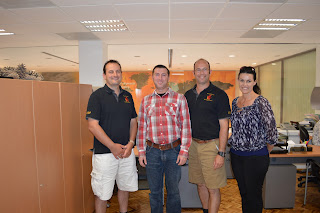Back on campus for the last day of this Nuffield trip, and an early start with the Conservation Tillage and machinery team. We met Jelle Van Loon at the conservation tillage plots looking at different rotations and cultivation techniques. Three main take home points from Jelle was keeping residue on the fields, cover crops with different rooting depths and rotation. Lots of crops are grown on permanent beds so that they can be flood irrigated. A few growers are starting to use trickle tape irrigation strips, requiring much less water but a higher set up cost. Periodically these beds need fortifying, or edging up and Jello and the team have been working on new machinery designs to complete this task.
One thing we were very impressed with was the way the team worked with local blacksmiths, engaging them to create machines conceived at CIMMYT. The machines, when at the prototype stage, are then tested at CIMMYT and only when they are happy is the final design, drawn up on 3D software. These intricate designs down to the size of the nuts and bots are then made available and distributed Free of charge to any local farmer that needs them. You can just image the type of machines being built and ideally suited to very local conditions.
Later in the morning we met up with Thomas Payne, who is head of the Wheat Germplasm Bank. This is where all the previous varieties of wheat and maize are stored. The store also includes wild varieties that are being stored to potentially extract the germplasm (genetic's) later to see if they can help with a future problem. There are 144,000 varieties stored here and of these 50% have undiscovered germplasm. The picture above is a diagram of a CIMMYT variety of wheat's genetic parentage and is made up of wheat varieties bred from all over the world. This vault was at about zero degrees C but downstairs at the lab, the deep freeze is at -18 degrees C and it's used for long term storage of germplasm. It is estimated tat varieties of wheat here will remain in viable storage for 100years at least!
Next up was Susanna Dreisigacker, who works with the Molecular Wheat and the Seeds of Discovery Project. This project is aimed at identifying varieties that haven't really been looked at yet. There is a target of 120,000 accessions to be analysed over the next 10 years.Susanna and her team are effectively marking specific genes with the plants that are linked to specific traits that are required by the breeders. There is new technology helping the team out, such as 'SNIP' markers. These genes and traits are being recorded and logged so that the are identified and so can be used in the future.
After a further meeting with Pawan Singh on wheat pathology, which was very interesting and we heard about the long term history of rust resistance breeding within the CIMMYT. Other diseases the breeders are targeting are Tan Spot, (increasing incidence with min-till), Fusarium Headblight, Septoria nodorum and spot blotches grouped together as blights.
Our last meeting was with Javier Pena who heads up the Grain Quality Laboratory. One of the key breeding requirements is for the end use. Can the wheat variety be used for chapatti's, nans or flat breads? Javier is looking for varieties with medium to hard endosperms with good protein levels. The softer breads tend to make breads that go stale too quickly, an important trait when you think about where in the world these varieties are going to be grown. It was a great way to round up the tour, actually seeing what eating qualities are targeted, so soften missed in communication to the end users. In summary the whole team are focused on four areas, high yield, disease resistance, environmental stress and end use quality.
To round off our time in Mexico we hired a taxi and headed out to the pyramids at Teotihuacan. Here we climbed the Pyramid of the Sun, thought be be built around 100AD. It was a great way to spend the last evening before we headed home early the following morning. Once again I can't thank the staff at both of the CIMMYT sites for organising a tremendous visit, being so open and forthcoming with their work, ideas and future thoughts.

















































